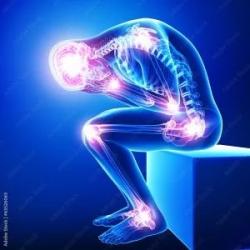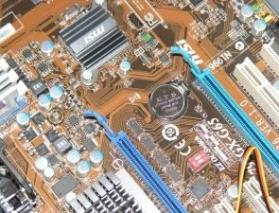 Over two decades ago, I injured my lower back lifting a heavy box out of the back of my car. It was an agonizing experience that boiled down to having what amounted to basically a soft tissue sprain at my sacroiliac joint. I will not minimize the pain experienced by people who have suffered far greater injuries than my own. There are people with ruptured discs, severe sciatica, actual broken vertebrae–I deeply sympathize with them. Enduring back pain of any degree can be a depressing, demoralizing, soul-draining experience. I got off lucky. I can only speak to my own experiences and how they have transformed me, which is my intention here. If I can lend any degree of hope or inspiration to those who suffer from any form of chronic pain, then writing this was time well spent.
Over two decades ago, I injured my lower back lifting a heavy box out of the back of my car. It was an agonizing experience that boiled down to having what amounted to basically a soft tissue sprain at my sacroiliac joint. I will not minimize the pain experienced by people who have suffered far greater injuries than my own. There are people with ruptured discs, severe sciatica, actual broken vertebrae–I deeply sympathize with them. Enduring back pain of any degree can be a depressing, demoralizing, soul-draining experience. I got off lucky. I can only speak to my own experiences and how they have transformed me, which is my intention here. If I can lend any degree of hope or inspiration to those who suffer from any form of chronic pain, then writing this was time well spent.
I will not linger on the details; suffice it to say that I have suffered a degree of chronic instability, stiffness, and utter lack of stamina in my lower back for about 24 years due to one ill-advised action. Sitting down for a sustained period of time is my back’s greatest nemesis. Long car rides or airplane trips are nightmares. The stiffness and fatigue is when it is at its best. At its worst, I experience debilitating back spasms that can leave me in a fetal position on the floor for half an hour before I can even move. It takes at least five days to recover fully from such an episode.
I have seen dozens of medical professionals over the years to see what advice they could offer or what interventions they could prescribe. Some of their suggestions amounted to throwing darts at a dart board, alleviating immediate symptoms while hoping to stumble upon some follow-up exercise that might in some way help prevent future occurrences. About six years ago, I finally found a physical therapist who really knew her craft, who listened, and who helped me change my paradigm. I have not experienced a spasmodic episode since following the program she designed for me–something that has been life changing. All the same, the pain remains. I will never fully heal. I am 52, and as I continue to age, things will likely worsen. I can’t imagine being 86 like my parents are, being barely able to walk around unassisted, and at the same time remaining capable of the variety of exercises that have brought me some relief over the last six years. What am I to do then?
Well, I once found it easy to fall into a “woe is me” mindset, cursing whatever forces of destiny conspired to take a fully-healthy prime of my life away. I could, if I so chose, spend my days wallowing in self-pity and fear of the inevitable challenges that lie ahead. That’s certainly an option. Today, every time my thoughts even consider wandering in that direction, I recall a passage from J.R.R. Tolkien’s The Lord of the Rings. This is Frodo Baggins lamenting his situation with Galdalf the wizard: “I wish the ring had never come to me. I wish none of this had happened.” Gandalf responds: “So do all who live to see such times, but that is not for them to decide. All you have to decide is what to do with the time that is given to you.” Boom. I can decide to let my present moment slip away in regret and misery, or be grateful for what I can still do and for the joys of life I am still able to experience. How could a reasonable individual consciously choose the former option?
We can turn to the ancient Stoics as well to help steer us away from the “woe is me” mindset. Take Marcus Aurelius in these passages from the Meditations:
- “Of Pain. If it is past bearing, it makes an end of us; if it lasts, it can be borne. The mind, holding itself aloof from the body, retains its calm, and the master-reason remains unaffected. As for the parts injured by the pain, let them, if they can, declare their own grief” (Book Seven, Passage 33).
- “When it pain, always be prompt to remind yourself that there is nothing shameful about it and nothing prejudicial to the mind at the helm, which suffers no injury either in its rational or its social aspect…Pain is never unbearable or unending, so long as you remember its limitations and do not indulge in fanciful exaggerations” (Book Seven, Passage 64).
- “Pain must be an evil either to the body–in which case let the body speak for itself–or if not, to the soul. But the soul can always refuse to consider it an evil, and so keep its skies unclouded and its calm unruffled” (Book Eight, Passage 28).
- “Nothing can happen to any man that nature has not fitted him to endure. Your neighbor’s experiences are not different from your own; yet he, being either less aware of what has happened or more eager to show his mettle, stands ready and undaunted. For shame, that ignorance and vanity should prove stronger than wisdom!” (Book Five, Passage 18).
There are many, many more, and I would recommend keeping a copy of this book by your bedside to help you retain perspective as you grapple with physical or emotional pain. At the same time, does my drawing your attention to these passages not seem to reek of hypocrisy? You may be thinking: “So if all you need is a copy of Lord of the Rings and some old, dusty, ancient philosophy, why are you exercising? Why did you even seek out a physical therapist? Isn’t it all just in your head?” It is one thing to say to someone who is suffering great pain, “Here, read this book/passage and gain some perspective. Just overcome it with strength of will.” That’s easy for someone who isn’t in constant pain to say.
So am I saying that we should be shaming people who are in pain, accusing them of being weak-minded while urging them to just suck it up? Not at all; our perspectives are just a piece of the puzzle. Fortitude or resilience in the face of pain isn’t only about how we view it. It’s also about not giving up. It took me fifteen years of looking for someone who could really and authentically help me on the physical side of things. The key is I never stopped looking. My quest didn’t cure me, but it did help arm me with more resources to minimize and control the pain I did have. I still read Marcus Aurelius and Tolkien, I still exercise every single day as meticulously instructed by a therapist I trust–and the pain goes on. What if it was so intense that I could not get out of bed? Would I still be singing philosophy’s praises? I can’t say. Only when we experience a situation do we really know how we will deal with it. There are many pains I have never experienced, such as a migraine, or giving birth to a child. There are others I have yet to experience but are looming in the future, such as the death of an aging parent (unless I go first that is). All of our pains are different, as we as people are different. Whatever your greatest pain is, just keep seeking answers, and never give up–no matter what. Seek a means of its elimination, and while that quest proceeds, work to accept the lessons the pain can teach you.
I have come to regard my back pain as something of a spiritual guide. It’s like a little voice in my mind that says, “Hey, I’m still here. Pay attention! You need to exercise today, not only to satisfy me and lower my voice, but because it is generally good for you. So get after it!” Without the pain, would I have the same motivation to exercise that I do today? When I exercise as I was taught, the pain lessens or goes away–at least for a little while. It motivates me to act in my best interest. I have a pretty self-disciplined routine at this point that might not exist had I never been injured. With luck, I will be able to sustain a level of overall flexibility and strength heading into my later years that will at least minimize the pain I feel, and hopefully help prevent other conditions associated with age and a sedentary lifestyle. So, I owe my current level of strength and flexibility to the little spiritual guide in my back.
Sometimes, the voice says something like: “Hey! At least you can still walk, work, and do most of the things you need to do. Be happy about that, and don’t take the time you still have and the capabilities you still possess for granted!” That’s what it says if I have a “woe is me” moment. It helps snap me out of my self-induced pity mode and to appreciate what I still have and can do. The stoics always strive to view the world as it is, without the burden of irrational, emotional impressions that our brains can work to impose over the top of the truth. The pain is what it is, but it does not have the power to dictate to me how I should respond to it. My mind can choose to view it as an ally, not an adversary. I have a “response-ability” (an ability to respond) and can decide what degree of power I give to events or conditions external to me. The injury might be inside me, it may send powerful messages to my brain via my nervous system, but I still control how I react to those messages.
Pain is a part of who we are. We need it, as it warns us of danger. There are also “good” kinds of pain, like the burn in your muscles as you exercise and push them to grow. Your muscles are sore the next day, which is also a good sign. Sometimes the narrators to motivational workout videos tell you that “pain is temporary,” and that by powering through it you will make yourself stronger in the end. They also say this applies to emotional pains, like stress, loss, et cetera. To some degree this is true. We have to endure pain to grow, be it physical or emotional. At the same time, those that suffer from chronic pain know that not all pains are temporary; there are just some that we have to learn to live with. All of us live with some sort of pain. We have losses to which we must adapt, and we often carry regrets for past mistakes (though holding on to regret is counterproductive; we need to learn the lesson from the incident and move forward, letting the regret go). We need to learn to view our pain, as much as it is possible to do so, as a teacher and guide; a motivator that can give us a swift kick in our complacency when we need one; a teacher that can remind us of the lessons learned from mistakes we have made.
We are all congregants in the “church of pain.” Some of us attend sporadically, some weekly, and some constantly. Some are more vested than others in the messages pain sends, and we each view those messages from different perspectives. Pain is a part of all of our lives, and life is hard. We will all suffer in many different ways before our journey’s end. Pain, like mortality, is part of the truth of our existence. To fight against it, to treat it as an adversary, will only amplify its effects and lead to an enhanced degree of misery that our minds helped to bring about. If we can, we need to accept it and learn from it, while working to mitigate it so that we can control it and still move forward. It can remind us, like breathing does, that we are still alive, and while we live, we can hope.
Subscribe to The Spiritual Naturalist Society
Learn about Membership in the Spiritual Naturalist Society
__________
The Spiritual Naturalist Society works to spread awareness of spiritual naturalism as a way of life, develop its thought and practice, and help bring together like-minded practitioners in fellowship.
Works Cited:
Aurelius, Marcus. Meditations. Translated by Maxwell Staniforth. London: Penguin Books, 1964.

















